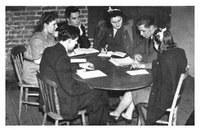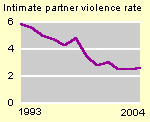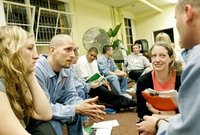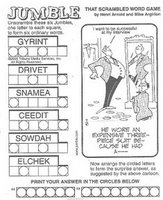 during my term as a piece of furniture consisting of a seat, legs, back, and often arms, designed to accommodate one person, i’m at least partially responsible for the content of faculty meetings. at the request of undergraduate advisor ann miller, we allocated fifteen minutes of monday’s meeting to a presentation on the use of mid-semester course evaluations.
during my term as a piece of furniture consisting of a seat, legs, back, and often arms, designed to accommodate one person, i’m at least partially responsible for the content of faculty meetings. at the request of undergraduate advisor ann miller, we allocated fifteen minutes of monday’s meeting to a presentation on the use of mid-semester course evaluations.
a representative from the minnversity’s center for teaching and learning introduced a model called student feedback through consensus. here’s how it works: a consultant comes to your class, asks students what’s working and what changes they would recommend, and meets with you confidentially to share the results. in the next lecture, you can then reflect the students’ concerns, reiterate your priorities, and explain your response to the recommendations.
i’m not sure i’ll use a consultant, but i always try to evaluate my courses as i teach them. i distribute midterm evaluation forms, with the first few questions mirroring those on my official end-of-semester evaluation forms. the front side of the form consists of likert-type items (e.g., the lectures are clear and well-organized; the professor is available to me outside of class; the professor resembles “beavis”), with some open-ended items on the reverse (e.g., would you like me to lecture more on readings? more discussion of hot topics? more theory applications and examples? whaddayawant?; do you think the exam format and grading have been fair? why or why not?).
when i reflect their responses, it gives me the chance to show the diversity of tastes and expectations in the class (e.g., some people really like my riffs on theory) and to reiterate my priorities and goals for the semester. i am usually open to changing test formats and will occasionally trim a reading or two, but students typically request much simpler changes. for example, i’ve been asked to put black-and-white rather than color handouts online, saving them a few dollars in printer cartridges. i also try to throw a few fun questions into the mix, which seems to liven up the discussion.
i’m convinced that midterm evaluations can simultaneously enhance student learning and one’s end-of-semester evaluations. they provide a quick heads-up on students who are really upset and an opportunity to clarify misinterpretations or make good on mistakes. for example, a student last year felt my delinquency class had an anti-immigrant bias, primarily because my social disorganization theory lectures and readings tied immigration to disorder and high crime rates. i appreciated the opportunity to get another shot at teaching these ideas and the students seemed to appreciate a more thorough discussion of immigration and crime. they certainly nailed the disorganization question on their final exams.
despite my support for midterm evaluations, i was a little nervous during monday’s faculty meeting. at the start of the midterm evaluation presentation, our speaker asked our busy faculty to form small groups and set them to work on a task. uh-oh, i thought. even though many of us ask students to form small groups for class exercises, i didn’t know whether her task would fly. how would your colleagues react if they were asked to get into small groups at the next faculty meeting?
i’m happy to report that the exercise was useful and thought-provoking. i’m even happier to report that my colleagues jumped into the unexpected task with good will and a bit of enthusiasm (perhaps because the speaker was well-organized and stuck to her allotted fifteen minutes). even so, i can imagine a few professors in a few departments being somewhat less cooperative. we didn’t complete any evaluations for the session, but i suspect they would have been quite positive.
 i’m not sure which of my clever students or coworkers ratted me out, but i’m going back to jail on may 17. this is gonna seriously mess up my syttende mai plans.
i’m not sure which of my clever students or coworkers ratted me out, but i’m going back to jail on may 17. this is gonna seriously mess up my syttende mai plans.






 during my term as
during my term as